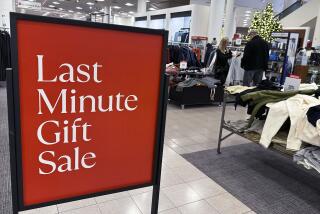Consumers : Shipping Out for the Holidays
- Share via
Is your mailbox beginning to bulge with glossy books advertising steaks, sweaters or sweets? Be advised: ‘Tis already the season for Christmas catalogues.
October is the traditional time for stores and catalogue houses to send out their books for customers to peruse, then pick gifts for friends and relatives for the holiday season.
Today, there are more catalogues than ever--an estimated 7,000 of them, industry analysts say.
“Now that the Christmas catalogues are coming in, I get about 15 or 20 a week,” said Amy Britt of Los Angeles. “The busier I get, the more I rely on them. I do Christmas shopping, buy gifts for people who live in other states. You have to mail them anyway, so you might as well have the catalogue company do it. And I get some things for myself.”
Britt, an environmental engineer for an oil company, explained that she prefers the convenience of shopping at home to taking the time to tramp through crowded malls searching for presents: “You can stay home and relax and it’s nice to look through them. It’s a low-pressure way to shop. There’s nobody standing over your shoulder. You can just do it by yourself in your own time.”
A decade ago when she got out of college, Britt joined the burgeoning ranks of catalogue buyers who have made catalogue sales the current growth area of retailing.
There are now 88.5 million catalogue shoppers nationwide who will spend about $25 billion to $35 billion this year, according to the Direct Marketing Assn., an industry trade group headquartered in New York City.
Though American retail catalogues, which trace their lineage to Benjamin Franklin’s offering of a list of books in 1744, once targeted consumers in rural areas who lacked easy access to big-city stores, today the industry tends to tackle upscale shoppers, many in urban areas. The trend is toward specialty collections selling a particular product or line. Industry watchers agree that catalogue shoppers cover a wide demographic range from baby boomers to the elderly.
Today’s catalogue shoppers also will find shopping easier and faster than it used to be, because many companies have toll-free numbers for ordering; others offer overnight or two-day service for a nominal extra fee.
It doesn’t take weeks for an order to reach the U.S. consumer any more, unless it is going overseas. Many catalogue companies can ship to post-office boxes, or to APO boxes and foreign countries. Consumers can inquire with the catalogue company customer-service representatives.
Some companies have 24-hour hot-line numbers for customer assistance; some, such as Spiegel, will send UPS to pick up your returned items free.
Many catalogue companies also offer additional specialized services, among them sizing charts for clothing and shoes, gift wrapping, monogramming and gift certificates.
Omaha Steaks sends a free cookbook with any item ordered. The company, which also sells seafoods and other meats, employs a home economist to take customer queries on a toll-free line about food preparation and ingredients. Many garden catalogues offer customers the convenience of talking with a horticulturist about plant problems. Royal Silk will provide a videotape to consumers that tells them how to wash silk garments.
“The whole name of the game today (in catalogues) is giving customers service and convenience,” said Lisa Caugherty, executive director of the direct marketers’ group. “Companies can ship the merchandise later and later--some as late as Dec. 15 or Christmas week--and many offer unconditional satisfaction and money-back guarantees.”
When buying through catalogues, the first thing consumers should do, she advised, is to check out the company’s satisfaction guarantees and return policies to ensure they can get a new item or money back.
“For refunds, consumers will be reimbursed in the manner in which they originally paid,” she said, explaining that’s a provision of the federal Fair Credit Billing Act. “If they paid by credit card, and return the item, that will be removed from their bill in one billing cycle. If they paid by check, the company will issue them a refund check in seven business days.”
If an item was charged on a credit card but returned, it’s a good idea to let the credit-card company know about the transaction. This is especially important if customers are unhappy with merchandise and want the credit-card company to not pay for it until they get what they want.
But consumers can help avert disputes, in part, by filling out order forms “carefully and keep a record of it, and the check number,” Caugherty said.
It’s the company’s responsibility to ensure delivery of merchandise; contact the company about missing shipments and they can check with UPS or parcel post.
If the product arrives damaged, Caugherty recommends that consumers “save the packing material and contact the company.”
And if the company sends you the wrong merchandise? “It is responsible for the return postage,” she said.
The direct marketers’ this month will publish a guide to catalogue buying, advising consumers on ordering and their legal protections. It will list 50 product categories and information about its 250 member catalogue companies. The $3 “Great Catalog Guide” can be ordered by writing the group at 6 E. 43rd St., New York, N. Y. 10017.
CONSUMER VIEWS
Meet the U.S. Customs Service, Page 4.
NEW AND USEFUL
High-tech aerobic roller skates, Page 4.
More to Read
Inside the business of entertainment
The Wide Shot brings you news, analysis and insights on everything from streaming wars to production — and what it all means for the future.
You may occasionally receive promotional content from the Los Angeles Times.










